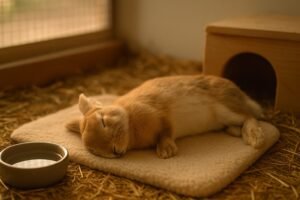When winter arrives, ensuring your pet rabbits stay warm becomes a top priority for responsible owners. While rabbits have fur coats that provide some natural insulation, domesticated bunnies often need additional help to withstand cold temperatures, especially if they live outdoors year-round. Proper winter preparation can mean the difference between rabbits that merely survive the freezing and those that remain healthy, active, and comfortable throughout the winter months.
In this comprehensive guide, we’ll explore essential strategies to keep your pet rabbits warm and protected during even the most extreme cold weather conditions.
Preparing for Cold Weather
Successful winter rabbit care begins long before the first frost, with careful preparation being key to keeping your pet rabbits warm and healthy throughout the cold season.
Research and Monitor Weather Conditions
Research and prepare for extreme cold weather conditions to keep pet rabbits warm and safe – a crucial aspect of rabbit winter care. While wild rabbits have adaptations for winter survival, your pet rabbits rely on you to provide adequate protection from harsh elements.
Check the weather forecast regularly to ensure you’re aware of any sudden temperature drops that may affect your outdoor rabbits. Being proactive about weather monitoring allows you to take preventative measures before temperatures reach dangerous levels.
Stock Up on Essential Supplies
Stock up on warm bedding material, such as straw and hay, to provide extra warmth for your rabbits in cold temperatures. Straw is particularly effective for insulation because it traps warm air better than hay, though both materials are useful during winter months.
Consider investing in a heat lamp or heating pad to create a warm air source for your rabbits, especially in freezing temperatures. However, always ensure any heat source is positioned where rabbits cannot chew on cords or come into direct contact with hot surfaces.
Make sure you have a sufficient supply of food and water to keep your rabbits nourished and hydrated throughout the winter months. Remember that rabbits require extra calories during cold weather to maintain body weight and generate heat.
Creating a Warm Environment for Pet Rabbits
Creating a cozy environment that retains heat while allowing fresh air circulation is essential for keeping your rabbits warm during winter.
Bedding and Sleeping Areas
Use dry hay and straw to create a warm and cozy sleeping compartment for your rabbits, protecting them from cold temperatures and dampness. Layer the bedding thickly in sleeping areas – at least 4-6 inches deep – to allow your rabbits to burrow and create their own warm pockets.
Provide a warm and comfortable nest box or hideout for your rabbits to retreat to when they feel cold, lined with warm bedding material. Nest boxes simulate the burrows that rabbits would create in the wild and help them conserve body heat during particularly cold nights.
Change bedding regularly to ensure it stays dry and clean, as wet bedding can freeze fast and cause more harm than good. A good practice is to spot-clean daily and perform a complete bedding change at least weekly.
Insulation Techniques
Ensure that your rabbit’s outdoor enclosure is well-insulated and protected from wind, rain, and snow to keep them warm and dry. You can line the hutch with cardboard for extra insulation, creating a buffer between your rabbits and the cold outside air.
Use blankets or covers to keep the cold air out and the warm air in, but make sure they are safe and won’t cause your rabbits to overheat. Many rabbit owners use specialized hutch covers or repurpose old blankets, making sure to secure them properly against the wind.
Consider bringing your rabbits indoors during extremely cold weather to keep them warm and safe, providing a warm and comfortable housing environment. A garage, utility room, or mudroom can provide shelter without disrupting your house floor plan.
![A well-insulated rabbit hutch with protective covering and elevated from the ground to keep rabbits warm in winter]
Outdoor Rabbit Care and Safety
Outdoor rabbits face particular challenges during winter months, requiring special attention to their enclosures, feeding schedules, and protection from harsh weather conditions.
Enclosure Safety and Placement
Make sure your rabbit’s outdoor enclosure is safe and secure, protecting them from predators and harsh weather conditions like freezing temperatures and snow. Predators can become more desperate during winter, so reinforce any weak points in your enclosure.
Position hutches and cages away from prevailing winds and elevated off the ground to prevent the cold from seeping up from below. This simple adjustment can significantly increase the temperature inside the enclosure, helping your rabbits stay warm.
Check the enclosure regularly to ensure it’s free from damage and that your rabbits have enough space to move around, even in cold weather. Movement is essential for maintaining body heat and preventing health issues.
Nutrition and Water Management
Provide extra food and water for your rabbits during cold weather, as they need more calories to stay warm, and ensure their water bottles and dishes don’t freeze. Rabbits may increase their food intake by 10-15% during winter, so adjust portions accordingly.
Consider using a heated water bottle or bowl to keep your rabbit’s water from freezing, and provide warm water for them to drink throughout the day. Check water sources multiple times daily, as they can freeze fast in frigid temperatures.
When possible, position water bottles inside the sleeping compartment where it’s warmer, or wrap them in insulating material to slow the freezing process. Some owners rotate between two bottles, keeping one indoors while the other is in use.
Emergency Weather Protocols
Keep an eye out for signs of hypothermia, such as lethargy and cold ears, and seek veterinary care immediately if you suspect your rabbit is ill, especially in extreme cold. Having an emergency plan is essential for winter rabbit care.
During snow, rain, or particularly windy days, provide additional protection for your outdoor enclosure. Many rabbit owners find that a combination of blankets, plastic sheeting, and straw insulation works well to create a protective barrier.
Health Considerations for Rabbits in Winter
Cold temperatures can create additional health risks for rabbits, making vigilant monitoring and preventative care crucial during the winter months.
Monitoring Health and Wellness
Monitor your rabbit’s health closely during the winter months, as they can be more susceptible to illness in cold temperatures, and seek veterinary care if you notice any signs of illness. Weight loss, decreased appetite, or unusual behavior warrant immediate attention.
Ensure that your rabbit is getting enough exercise and mental stimulation, even in cold weather, to keep them healthy and happy. Exercise generates body heat and helps maintain a healthy weight during a season when rabbits might otherwise become sedentary.
Provide a warm and comfortable place for your rabbit to rest, such as a heated bed or a warm nest box, to help them conserve energy and stay warm. This is particularly important for older rabbits or those with thinner fur.
Special Considerations for Vulnerable Rabbits
Watch for signs of frostbite in your rabbit, including pale, discolored, or cold skin, particularly on the ears, feet, and nose. If you suspect frostbite, seek veterinary assistance promptly, especially during periods of extreme cold weather.
Older rabbits, young bunnies, and those with health conditions may require extra warmth during winter. Consider bringing these vulnerable animals indoors or providing additional heat sources to their enclosures.
Make sure your rabbit is eating and drinking normally, and seek veterinary care if you notice any changes in their appetite or behavior, as this can be a sign of illness or stress in cold weather. Dehydration is a common winter concern that can lead to serious health complications.
![A cozy nest box filled with straw showing the perfect winter retreat for a rabbit]
Winter-Proofing Your Rabbit’s Living Space
A properly winter-proofed living space provides your rabbits with protection against all the challenges winter brings, from freezing temperatures to dampness.
Insulation Strategies
Insulate your rabbit’s hutch or enclosure to keep the cold air out and the warm air in, using materials like straw and hay to provide extra warmth. Focus on creating multiple layers of protection between your rabbits and the outside elements.
Use cardboard to line the walls of the hutch, creating an additional barrier against cold. Some owners line the ground under elevated hutches as well to prevent cold air from rising into the living space.
Provide extra bedding, such as straw or hay, to keep your rabbit warm and comfortable, and change the bedding regularly to keep it clean and dry. Damp bedding quickly loses its insulating properties and can make rabbits sick.
Waterproofing and Moisture Control
Use waterproof materials to protect the hutch or enclosure from rain and snow, and ensure that the roof is secure and won’t leak, to keep your rabbits dry and warm. A rabbit that gets wet in winter is at high risk for hypothermia.
Check for any cracks or gaps in the housing structure where wind, rain, or snow might enter. Seal these with appropriate weather-resistant materials that are safe for rabbits and won’t be chewed.
Make sure your rabbit’s living space is well-ventilated to prevent the buildup of ammonia from their urine, and keep the air fresh and clean, even in cold weather. Proper ventilation prevents respiratory issues while still maintaining warmth.
Safe Heating Options
Consider using a heat source, such as a heat lamp or heating pad, to keep your rabbit’s living space warm, but make sure it’s safe and won’t cause your rabbit to overheat. Never leave heating devices unattended, and always protect cords from being chewed.
Some rabbit owners use hot water bottles wrapped in towels or specially designed snuggle pads that retain body heat. These can be placed in sleeping areas to provide additional warmth at night when temperatures are lowest.
Always ensure that rabbits can move away from any heat source if they become too hot. Having both warmer and cooler areas in the enclosure allows rabbits to self-regulate their body temperature.
Conclusion and Final Tips
Keeping your pet rabbits warm and safe during the winter months requires careful planning and attention to their needs, especially in extreme cold weather. By creating properly insulated housing, providing adequate nutrition, ensuring unfrozen water access, and monitoring their health closely, you can help your bunnies not just survive but thrive during winter.
Remember these essential points:
- Preparation before winter arrives is key to rabbit comfort and safety
- Layered bedding and proper insulation help rabbits stay warm naturally
- Regular monitoring of both enclosures and rabbit health prevents problems
- Adjusting food and water provision for winter conditions supports rabbit health
- Different rabbits may have different needs based on age, health, and coat density
By following these essential tips, you can help ensure your rabbits stay warm, healthy, and happy throughout the winter and provide them with a warm and comfortable living environment regardless of the temperature outside. With proper care and attention, your pet rabbits can enjoy the winter season as much as any other time of year.
Stay aware of the weather forecast and be prepared for any extreme weather conditions that may affect your rabbits, such as freezing temperatures, snow, and rain. Having emergency plans in place provides peace of mind and ensures your rabbits’ safety even during unexpected weather events.
With the right care and attention, your pet rabbits can thrive even in the coldest of winters and stay warm and healthy throughout the year.



